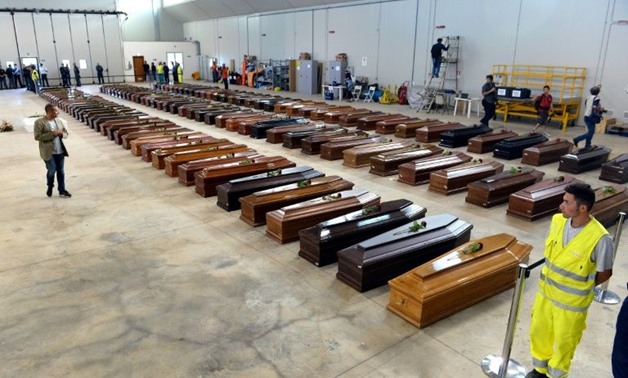
mages and recordings from the October 2013 tragedy in which 268 migrants drowned in the Mediterranean capture the horrific final hours of those whose deaths would shame Italy into launching a widescale search and rescue mission
18 October 2017: The death of dozens of children in a 2013 shipwreck after repeated SOS calls were ignored has returned to haunt Italy as survivors relive the nightmare in a new documentary.
Images and recordings from the tragedy in which 268 migrants drowned in the Mediterranean capture the horrific final hours of those whose deaths would shame Italy into launching a widescale search and rescue mission.
"A unique destiny: three fathers and the sinking that changed history," by Fabrizio Gatti was broadcast on television Sunday and will be the subject of a web series this week on the site of La Repubblica daily.
The documentary follows three Syrians: Mazen Dahhan, now a doctor in Sweden, Ayman Mostafa, a surgeon in Malta, and Mohanad Jammo, an anaesthetist in Germany.
All three lost children in the October disaster; the first two lost their wives to the waves as well.
Alongside home videos showing the children smiling, playing or singing, we hear the audio recordings of Mohanad Jammo's anguished appeals to the Italian coast guard.
"Water is coming inside, please hurry, please hurry. The boat is going down," he says, adding that there are around 100 children on board. It is 12.39pm on Friday October 11, 2013.
The fishing boat, which had set off from Zouara in Libya under the cover of darkness with nearly 480 people on board, was in Malta's search and rescue zone, 118 nautical miles south-west of the Maltese capital Valletta, when it ran into trouble.
"Call Malta," the Italians reply.
But Valletta insists Rome should deal with the emergency because the boat at this point is only 60 miles off the Italian island of Lampedusa. An Italian patrol boat, the Libra, is also just 45 minutes away, sailing between the sinking vessel and the island.
- 'People in the water' -
However, at 3.37pm, Rome orders the Libra to move out of the area, so Malta will be forced to carry out the rescue. At around 4pm, a Maltese reconnaissance plane spots and films the migrant boat.
"I immediately said that the boat seemed very unstable," says pilot George Abela.
"I called the Libra on channel 16 (reserved for emergencies) so many times, but nobody answered."
Back at the command centres, Valletta and Rome are at loggerheads. Malta urges Italy to send the Libra to the rescue, while Rome plays for time.
On both sides, the voices heard are calm -- that is until 5.07pm when Malta announces: "The plane has seen the boat capsize, people are in the water".
The Libra finally sets off towards the boat, arriving just before 6pm to cries of panic. Hair-raising images shot by rescuers show adults and children fighting to stay above the waves.
The three Syrian doctors were among the 212 survivors plucked from the sea. Twenty-six bodies were recovered that day, while 240 people are still missing, including around 60 young children.
The shipwreck sent a shockwave through Italy, which was reeling from the deaths just a week before of 366 migrants who drowned off Lampedusa.
In the days that followed, Enrico Letta's centre-left government launched a vast search and rescue operation between Sicily and Libya dubbed "Mare Nostrum", which would go on to save over 100,000 people in a year.
The Libra was often on the operation's front line and its commander Catia Pellegrino, the first woman to command an Italian military vessel, was awarded a presidential medal of honour.
Two investigations into manslaughter and failure to assist people in danger were launched against Pellegrino and several Italian officers, but were later dismissed.
Mare Nostrum was replaced at the end of 2014 by the EU's border agency Frontex. All operations are still coordinated by Italy, which continues to host thousands of new arrivals, but is trying to stop migrant departures from Libya.


Comments
Leave a Comment